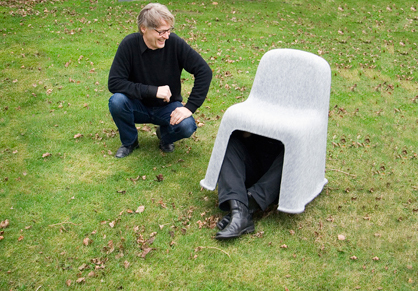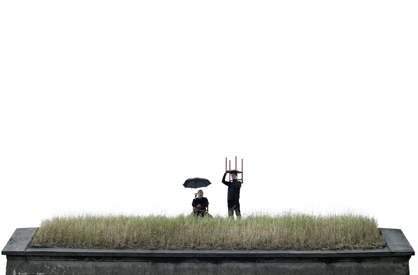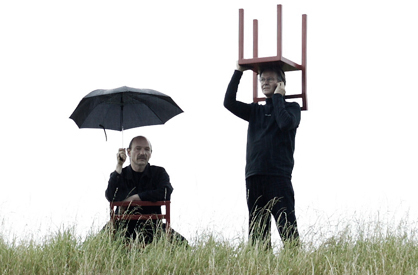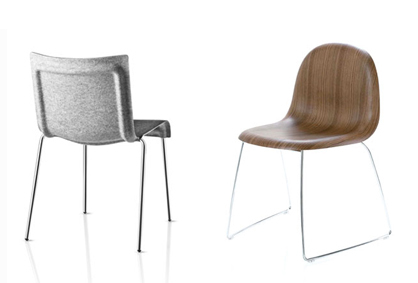"Designers become unlimited"
Texte par Nora Schmidt
Berlin, Allemagne
18.03.09
The Danes Poul Christiansen and Boris Berlin have been working together as Komplot Design for more than twenty years now. With their many and varied designs, which are characterised by cutting-edge and in many cases experimental production processes, they .
The Danes Poul Christiansen and Boris Berlin have been working together as Komplot Design for more than twenty years now. With their many and varied designs, which are characterised by cutting-edge and in many cases experimental production processes, they are among those designers who set international trends. We visited Boris Berlin at his studio in Copenhagen.
Poul Christiansen and Boris Berlin (under the Nobody chair by HAY)
Your designs always seem to have a technically innovative aspect. How do you start a project – what's your starting point?
What we're most interested in is the excitement which is generated when you link materials with non-typical production techniques or use them in a new context.
If we look at 'Nobody', for example - felt is the oldest form of fabric in human history. It can be formed seamlessly into all sorts of shapes. We discovered this polyester felt which is used in the automobile industry, for example, for rear parcel shelves in cars. It is produced of recycled PET bottles and can self be recycled.
So the material provided the initial spark for this chair?
In this case it was the material, yes. We wanted to display the technical production qualities of the material. With the 3D veneer of the 'Gubi' chair it was a similar process: the special method of processing gave us entirely new sculptural freedom with this two-dimensional material. This kind of thing is fascinating.
The “NON” chair on the other hand was developed on a different basis....
...Not that different – nobody tried before us to mould the whole chair in Polyurethane in one piece - we like the idea of the monoblock. It's simple and easy to understand. It's a single operational process, a single material and you know exactly what has to be checked. It isn't necessary to connect different elements with each other and, by the way, this makes the monoblock very environmentally friendly, too.
Boris, you're Russian and you were born in St. Petersburg. How did your career begin?
I completed my studies in 1975. Immediately afterwards I began work in Russia designing such things like photocameras. When I arrived here in the beginning of 80-s with my Danish wife I wasn't able to get a job in the industry here, of course – even if I included a note in my job applications that although I was Russian that still didn't make me a spy. So I initially worked mainly as a graphic designer. Then I got to know Poul in 1987 and together we founded 'Komplot'.
Your creative work covers a pretty wide spectrum: from graphic design via industrial design to furniture. Do you differentiate in your approach when you design products or furniture?
No, a piece of furniture is also a product.
But furniture has many cultural aspects, doesn't it?
Yes, that's true. That really is a big difference, and it's something I discovered quite late. In Russia there wasn't such a tradition with respect to furniture. I can't remember ever going into a shop there to buy furniture. Furniture was something you either inherited or found on the street. I even found many Thonet chairs – there was a Thonet factory in St. Petersburg. You mustn't forget that during the days of the Soviet Union historical continuity was interrupted in many areas, with the exception of art and literature.
When I arrived in Denmark I really did first have to learn that furniture is an essential part of our lives and that a chair is an object of cultural value. For us Europeans the chair is probably the most important item of furniture.
You can now look back on over 30 years as a designer. Have you noticed any changes?
Definitely. The role of the designer has changed. In the past a manufacturer would ask you to design something for him – and of course the design had to be in line with the available (in house) production processes. If you wanted to do something different you needed to have a very convincing project indeed. Otherwise only those things which the manufacturer himself was able to produce came off the production lines. As a result the best equipped manufacturers were the most important and the most flexible. The smaller producers either disappeared in the shadow of the big ones or tried to be flexible in a different way, for example by using the technology of other companies. This led to a certain trend towards outsourcing and since then the role of the designer has also changed. There are fewer restrictions on us, but at the same time the manufacturers are losing part of their technical skills. Somebody else now has to take over this know-how.
Do you mean the designer?
I don't think that the designer is capable of this – after all, we're talking about a very varied and wide-ranging profession. But it's right that nowadays designers have to be able to understand new technologies and learn how to use them a lot faster. At the same time they have much more responsibility – at least that's been my experience. When you design a product you also want to have it manufactured – but if the manufacturer doesn't have the necessary skills and concentrates on marketing and sales instead, then you need to intervene actively in the production process yourself, whether you want to or not.
But of course this flexibility enables a certain amount of specialisation?
Yes, sure, and that's good. It probably increases the amount of technical innovation and provides more scope for experiments – something that wasn't so usual in the past.
The wide spectrum of your work itself doesn't give the impression that you're a fan of specialisation.
I would say that by definition the designer is a universalist rather than a specialist. We regard ourselves as mediators between the user and industry. And in fact we are in the middle of everything: between art and construction, between poetry and economics – somewhere in a kind of no-man's land.
Let's talk about the user. Would you say that our understanding of design has changed?
Yes, design has gained significantly in importance. I can remember the time before designers were turned into pop stars. That wasn't the case in the 60s and 70s, for example. Except in Italy, of course. The Italians have always respected their designers, Sottsass, Bellini and so on. In the rest of Europe interest in designers developed later, unfortunately in a very superficial way and deriving above all from the type of glossy magazine which tells you what your lifestyle should be and sells you an entire furnishing scheme at the same time.
I would prefer people to furnish their own homes and to buy their things for a specific, entirely personal reason.
As the one who creates the spaces in which people live, the architect is also your customer, however. Do you always see your design within the context of the architecture which could surround it?
Yes, very much so. Our furniture can only exist within the context of architecture. Architecture is a dominant factor which absolutely has to be taken into account.
With the “NON”chair, for example, we wanted to exert a minimal influence on architecture with our design. In this connection I'm not thinking particularly of the architecture of Frank Gehry or Peter Cook. I'm thinking of architecture in general, inclusive medieval churches or baroque theatres – an item of furniture which will function in all possible environments. For me extravagance is not the most interesting in furniture design. You can't produce this kind of decorative cake all the time. That's like Marie Antoinette saying if the people don't have bread to eat "let them eat cake!"
I nevertheless find it great when objects have an identity of their own and tell a story. When I look at the 'Nobody', for example, it always reminds me of my childhood. My parents had a summer house in Russia and every time they were getting the house ready for winter they covered the furniture with sheets. When we came back in the spring I was always very excited by the thought of removing the sheets, wondering what could have happened underneath them in the time I had been away. For this reason the chair is called 'Nobody' (no body), because in fact it is only the cover for something which is non-existent.
Can you name me any contemporary objects by other designers which have aroused your interest?
Oh, that's something I'll have to think about.
Yes, 'Plop' by Hay. It's really sweet, charming, unpretentious and very clever. It makes you laugh and that's a good thing. I also like the sofa which Hella Jongerius created for Vitra and many other of her things. There's no major technology behind it, but it's a friendly cultural statement, very pleasant.
I like almost everything from Jasper Morrison. I like Fukasawa.
Can you detect any difference between design produced by men and that which is created by women?
Design created by women is often less controlled and more poetic, in a positive way. It's more relaxed. Women don't seem to have this need to create something that's completely “perfect”. I would be happy to create something less controlled in future myself.
Thanks for talking to us, Boris!









